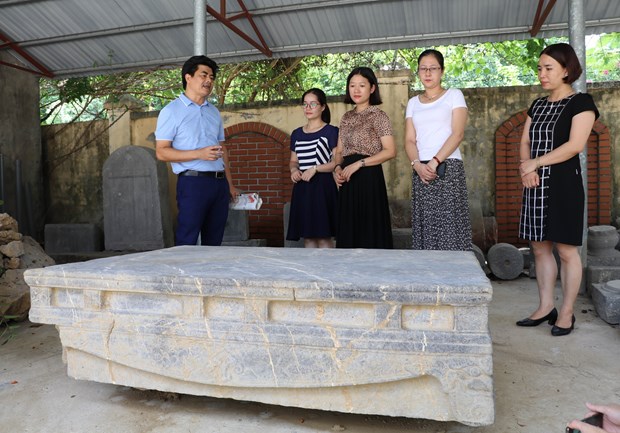 |
| Vietnamese archaeological professors and specialists visit the excavation site of the ancient brick tombs located in Gia Thuy Commune, Nho Quan District in Ninh Binh Province. — VNA/VNS Photo Hai Yen |
The results of the excavation were announced at a recent conference held by Ninh Binh Province’s Department of Culture and Sports, attended by specialists from the Institute of Archeology and University of Social Sciences and Humanities.
At the conference, the delegates discussed the historical and cultural values of the relic as well as plans to preserve and promote it.
The excavation of the ancient tombs began in July on a total area of 280sq.m within Gia Thuy Primary School located in Gia Thuy Commune.
The results have provided more scientific information about ancient tombs built in the first A.D. 10 centuries in Vietnam.
The tomb has rectangular structure with a dome, 8.46m in length divided into three parts. Its wall is made of two layers of bricks, the edges of which are decorated with patterns of different motifs while its bottom is flat.
The previous school yard leveling process had destroyed the entire tomb dome. The excavation also shows that the tomb has been excavated many times as the entire tomb has been disturbed while the ceramic burial items have been scattered.
“The research of its scale and the remaining objects reveals that the tomb belongs to a high-ranking mandarin in contemporary society, which is also a confirmation to the long-standing existence and the development of the land,” Quy said.
In addition, the excavation at My Ha Communal House also in Gia Thuy Commune where King Dinh Tien Hoang (924-979) and Queen Duong Van Nga (952-1000) are worshipped has revealed the foundations of an ancient house lying 0.5m deep underground.
The conference also discussed a plan to temporarily re-bury the brick tombs and foundations of My Ha Communal House to preserve the relics in the ground until there are further plans to promote their values in the future. Meanwhile, the land above could still be used as school grounds and serve the religious needs of the locals at My Ha Communal House.
According to Professor Lam Thi My Dung, also the director of the Museum of Anthropology, University of Social Sciences and Humanities, the excavation of the brick tomb relics and ancient architectural foundations will contribute to clarifying the cultural and historical values, as well as the role of Ninh Binh Province in the first ten centuries, particularly the formation and development of the country Dai Co Viet, an independent Vietnamese polity founded in 968 A.D. by the local warlord Dinh Bo Linh, in the 10th century.
She also suggested that Ninh Binh Province People's Committee should build plans and instructions to preserve and promote the values of the relics. In addition, the ancient brick tomb is located in the school yard of Gia Thuy Commune so it would be an opportunity to educate the students about the history of their hometown by setting up signboards and exhibiting photos. VNS

Brick tombs unearthed at school in Ninh Binh
Archaeologists have discovered four places with traces of ancient brick tombs at a local school in the northern province of Ninh Binh, according to local authorities.

Ancient rock bed found in Ninh Binh province
A rock bed dating back to the Le Trung Hung (Restored Le) era (1533 – 1789) was recently unearthed in Xich Tho commune of Nho Quan district, the northern province of Ninh Binh.